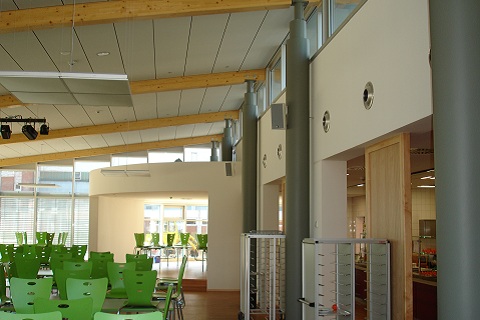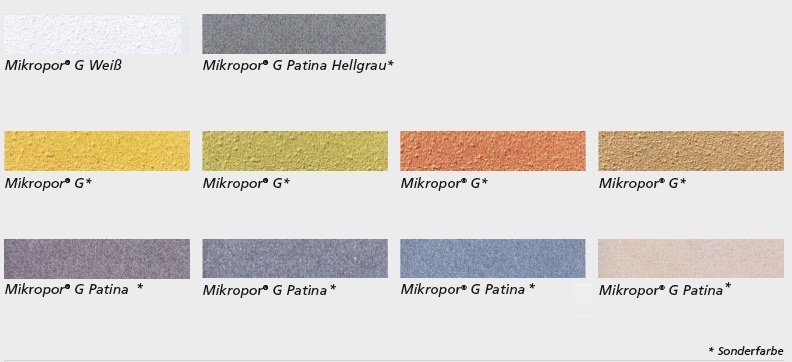We have specialized in the development of tested and VPAM-certified complete systems for indoor shooting ranges.
With us you will find complete solutions for sport shooters and biathletes up to 200 Joule, for civil and official indoor shooting ranges up to 1500 Joule and brand new our indoor system for ceilings and walls up to 3500 Joule.
- Civilian shooting ranges
- Indoor shooting ranges used by the police
- Indoor shooting ranges used by the Federal police
Generally speaking, one speaks of an indoor shooting range when the shooting range is enclosed by bullet proof walls, floors and ceilings. In addition to the acoustics and fire protection requirements placed on our materials there are considerably more mandatory guidelines and regulations to be observed when fitting out indoor shooting ranges. To name but a few these include those covering the ventilation of enclosed shooting ranges, (German) workplace directives, shooting range directives, employer's liability insurance association regulations, environmental protection laws, (BimSchG (Federal Emissions Act), TA Luft (technical instruction on air quality control), TA Lärm (technical instruction on noise abatement), KrWG pp (Closed Substance Cycle & Waste Management Act), miscellaneous building regulations and so forth.
Which weapons and types of ammunition are to be used in the shooting ranges must also be clarified. Generally speaking, there are no visible differences between the installed ceiling and wall systems and “normal” acoustic cladding solutions. However, there are some very sophisticated systems behind the panels including rebound protection to ensure the best-possible level of safety for both people and installation assets.
General information
When fitting out indoor shooting ranges it is first necessary to clarify the requirements and the resulting stipulations. Essentially, the different types of indoor shooting range are:
- Civilian shooting ranges
- Indoor shooting ranges used by the police
- Indoor shooting ranges used by the Federal police
Generally speaking, one speaks of an indoor shooting range when the shooting range is enclosed by bullet proof walls, floors and ceilings. In addition to the acoustics and fire protection requirements placed on our materials there are considerably more mandatory guidelines and regulations to be observed when fitting out indoor shooting ranges.
To name but a few these include those covering the ventilation of enclosed shooting ranges, (German) workplace directives, shooting range directives, employer's liability insurance association regulations, environmental protection laws, (BimSchG (Federal Emissions Act), TA Luft (technical instruction on air quality control), TA Lärm (technical instruction on noise abatement), KrWG pp (Closed Substance Cycle & Waste Management Act), miscellaneous building regulations and so forth. Which weapons and types of ammunition are to be used in the shooting ranges must also be clarified. Generally speaking, there are no visible differences between the installed ceiling and wall systems and “normal” acoustic cladding solutions. However, there are some very sophisticated systems behind the panels including rebound protection to ensure the best-possible level of safety for both people and installation assets.
Our experience tells us there are no standard solutions that can be applied universally to all shooting ranges.
As a rule, we work closely with planners and the expert person responsible for the measures to be implemented to create a system solution designed to fulfil the specific interests and requirements of the shooting range. And it goes without saying that we use tested and approved products.
We are able to provide you with a number of expert reports and bullet resistance tests through to the current certification issued by the Munich Proof House in accordance with VPAM ARG - 2012.
Preparatory planning
The current shooting range guidelines play an important role during the planning of new builds or conversion work on indoor shooting ranges. It is mandatory for an expert on shooting ranges to oversee planning, implementation and approval of the shooting range. Paragraph 5 of the shooting range guidelines “Enclosed shooting ranges” contains all safety-relevant principles. Particular consideration should be given to the following points:
Preventive fire protection
In accordance with the shooting range guidelines the whole area of the indoor shooting range is to be formed as a fire compartment. With that objective in mind the wall and ceiling cladding must be at least fire inhibiting (building material class B1 to DIN 4102 Part 1) or better non-combustible (building material class A).
Sound absorption
Sound absorbing materials are unavoidable for shooting in enclosed shooting ranges. Without such measures a reverberation effect would be created that would make it practically impossible to use these rooms.
Surfaces as smooth as possible
Due to the possibility of dust particles being deposited and increased difficulty cleaning, wall cladding with profiled surfaces are not suitable for indoor shooting ranges.
Easy installation systems
It must be possible to replace sound absorbing elements without involving excessive time and costs once they are damaged or shot to pieces. Consequently, simple installation systems are to be preferred.
Narrow wall gap
The wall and ceiling cladding should be mounted with a close clearance to the enclosing parts, because as a rule this increases the efficacy of the cladding and it can also reliably withstand being struck by rebounding and ricocheting bullets.
Colour design
The colour of the visible surfaces of the sound absorbing wall cladding should be Pastel green (e.g., RAL 6019) or Agate grey (e.g., RAL 7038).
Construction with Mikropor® G A2 acoustic panel and aluminium hat channels LAH 65 and LAH 59 from Lahnau Akustik GmbH
- Different installation systems are possible
- From visible screw connections to hanging systems through to different hat channel versions ( e. g., LAH 65 or LAH 59 according to Report no.01/2010)
- Also available with a coat of mineral wool in hollow spaces (see acoustics curve in the chapter Acoustics tests certificates). For detailed information please contact the responsible company representative or contact our company directly.
Mikropor ® G A2 in indoor shooting ranges – assessment
In accordance with the general building inspectorate approval Mikropor® G is fire inhibiting or non-combustible to DIN 4102, Part 1, Building material class B1 or A2. As a consequence the material can be used for interior finishing of enclosed shooting ranges. Sound absorption measurements to DIN ISO 354 certify that the material has good sound absorbing properties and reduces the existing sound pressure level in a room as a consequence.
According to Assessment report No. 01/2010 the hat channels LAH 65 and LAH 59 are excellently suitable for installing acoustic panels Mikropor® G A2 in indoor shooting ranges. Based on paragraph 5.5.3.2 of the indoor shooting range guidelines the material fulfils the specified requirements. The surface of the material can easily be cleaned using a vacuum cleaner.
It is as equally possible to wipe it clean with a damp cloth as it is to brush it clean with a horsehair brush. All installation versions are reversible. There are no limits on the choice of colours. The Mikropor® G acoustic panel can be supplied in any desired colour tone.
Conclusion: The combination of resistance to mechanical stress loads as well as the elasticity of the material Mikropor® G and as attested in Report nos. 04/2007 and 01/2010, the Mikropor® G acoustic panel and hat channels LAH 65 and LAH 59 fulfil the requirements of the shooting range guidelines.
Products from Lahnau Akustik offer numerous design options. We offer a huge choice of special colours and surfaces. We are happy to offer advice.
Surface:
Acoustic membrane with matt, smooth and non-directional surface, optionally available as sound absorbing (G) or sound reflecting (GT)
Surface colour (visible side):
In special colours as per sample on request; optional antistatic, water-repellent special coating
MIKROPOR® G
Non-directional, fine-pore structured colour coating light reflectance value (white) > 90% (diffuse: 0.9)
MIKROPOR® GT
This version as Mikropor G but sound reflecting.
MIKROPOR® G PATINA
Non-directional, matt, smooth coloured surface coating
(the colour and structure shown in images of surfaces can differ slightly from the original) * Special colour
1. Cleaning
- Before cleaning with a damp cloth, carefully remove surface dust with a brush or vacuum cleaner.
- It is possible to remove localized soiling such as fingerprints or trails of soiling close to air outlets using a firm, damp sponge together with a commercially available household cleaner or Moisture-Clean (available as a powder from Lahnau Akustik) in the respective recommended concentrations.
- Then carefully wash down the cleaned surface with clean, clear water and dab dry with an absorbent cloth or paper (kitchen roll).
- We recommended you test clean an inconspicuous area each time before cleaning.
Professional refurbishment must be carried out using Wilhelmi acoustic paint WAF-R 86 (special colours WAF-R 87).
- Quantity used during refurbishment: 400-700 g/m² depending on the degree of soiling
- Ensure the room temperature does not fall below 12 °C when applying the coating; the relative humidity should not exceed 70%.
- Once applied immediately ensure the rooms are ventilated and dehumidified.
2.1 Refurbishment
If the acoustic ceiling has become heavily soiled after many years of normal use and can no longer be cleaned properly, it is possible to restore it to a condition virtually as good as new by applying a refurbishment spray.
When applied professionally in accordance with the manufacturer’s instructions the acoustic absorbency of the wall or ceiling surface is not impaired. The refurbishment can be repeated several times, if required.
Under no circumstances should emulsion paints be applied to the surfaces using a brush or roller, otherwise the sound absorbing properties will be lost.
It is only possible to guarantee the acoustic characteristics will be retained by engaging a professional company that uses the appropriate coating machinery to professionally apply the refurbishment spray, e.g.,
Strobl Beschichtungstechnik GmbH
Hermann-Volz-Straße 50
D-88400 Biberach/Riß
Tel. +49 7351/4400-0
Fax +49 7351/4400-60

Quality management
It is possible to achieve continual improvement with the aid of quality management by involving all members of staff and optimizing company procedures across all departments. Fulfilling customer requirements is central to all we do. An integrated management system for quality, environment and occupational health and safety according to EcoStep.
Environment management
As a manufacturer of environmentally friendly products based on the raw materials glass and metal Lahnau Akustik GmbH is passionately committed to protecting the environment. We wish to contribute towards balancing economy and ecology with the aim of combining sustainable development with the careful use of resources.
The ecological benefits of acoustic panels made of recycled glass:
- 100% recycled glass
- Sustainable
- Conserve natural resources
- Winner of many ecological awards
- Optimize your LEED rating
- Healthy home environment “built-in”
- Reduce CO2
- Optimize heat insulation
With you in mind, we have introduced:
An integrated management system for quality, environment and occupational health and safety. An expert assessment documented in a report verifies that the management system fulfils requirements and, as a consequence, the core stipulations of the following standards:
- ISO 9001:2000
- ISO 14001:2004
ILO guidelines on occupational safety and health (2001)


